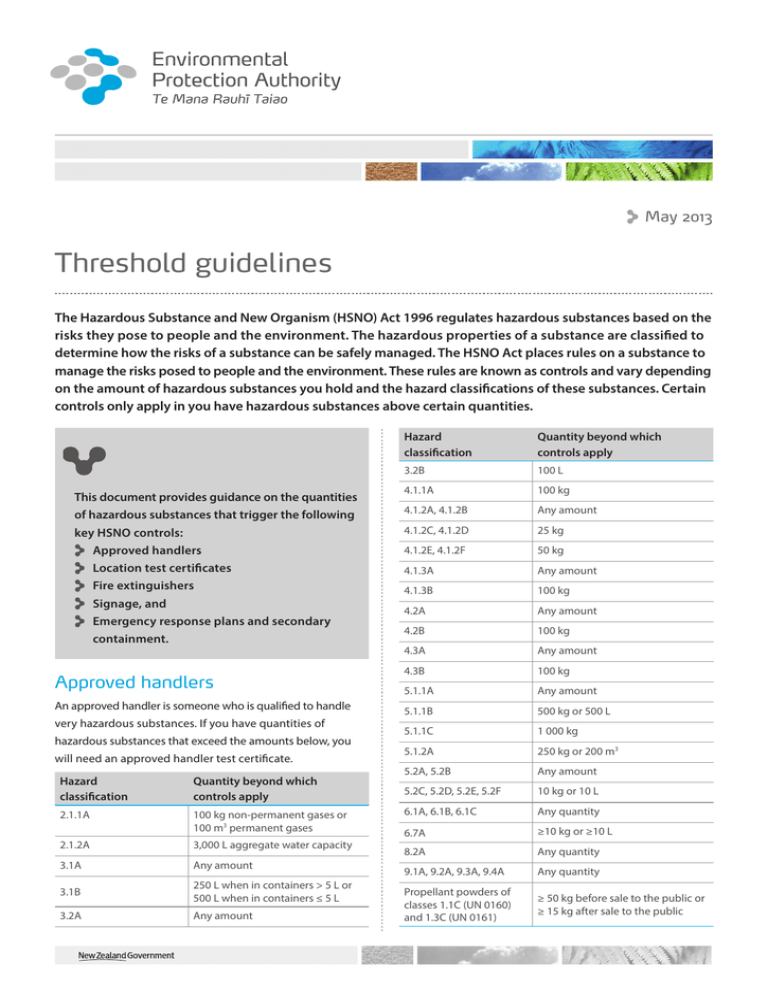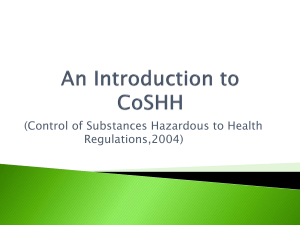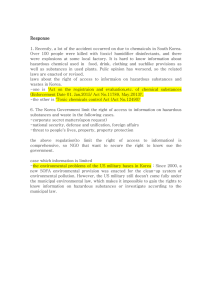Threshold guidelines
advertisement

May 2013 Threshold guidelines The Hazardous Substance and New Organism (HSNO) Act 1996 regulates hazardous substances based on the risks they pose to people and the environment. The hazardous properties of a substance are classified to determine how the risks of a substance can be safely managed. The HSNO Act places rules on a substance to manage the risks posed to people and the environment. These rules are known as controls and vary depending on the amount of hazardous substances you hold and the hazard classifications of these substances. Certain controls only apply in you have hazardous substances above certain quantities. This document provides guidance on the quantities of hazardous substances that trigger the following key HSNO controls: Approved handlers Location test certificates Fire extinguishers Signage, and Emergency response plans and secondary containment. Approved handlers An approved handler is someone who is qualified to handle very hazardous substances. If you have quantities of hazardous substances that exceed the amounts below, you will need an approved handler test certificate. Hazard classification Quantity beyond which controls apply 2.1.1A 100 kg non-permanent gases or 100 m3 permanent gases 2.1.2A 3,000 L aggregate water capacity 3.1A Any amount 3.1B 250 L when in containers > 5 L or 500 L when in containers ≤ 5 L 3.2A Any amount Hazard classification Quantity beyond which controls apply 3.2B 100 L 4.1.1A 100 kg 4.1.2A, 4.1.2B Any amount 4.1.2C, 4.1.2D 25 kg 4.1.2E, 4.1.2F 50 kg 4.1.3A Any amount 4.1.3B 100 kg 4.2A Any amount 4.2B 100 kg 4.3A Any amount 4.3B 100 kg 5.1.1A Any amount 5.1.1B 500 kg or 500 L 5.1.1C 1 000 kg 5.1.2A 250 kg or 200 m3 5.2A, 5.2B Any amount 5.2C, 5.2D, 5.2E, 5.2F 10 kg or 10 L 6.1A, 6.1B, 6.1C Any quantity 6.7A ≥10 kg or ≥10 L 8.2A Any quantity 9.1A, 9.2A, 9.3A, 9.4A Any quantity Propellant powders of classes 1.1C (UN 0160) and 1.3C (UN 0161) ≥ 50 kg before sale to the public or ≥ 15 kg after sale to the public May 2013 2 Threshold guidelines EPA0198 Location test certificates Emergency management A location test certificate is needed at hazardous substance locations where explosive, flammable or oxidising substances are stored or used and the quantity exceeds the threshold set out in legislation. If you store quantities of these substances that exceed the amounts below, you will need a location test certificate. If you store hazardous substances at your site you need to put measures in place so that if an incident or emergency occurs, the effects are minimised or controlled. The quantity and hazard classifications of the substances you hold will dictate the level of emergency management you require. Hazard Quantity beyond classification which controls apply for closed containers Quantity beyond which controls apply when use occurring in open containers 2.1.1A , 2.1.1B 100 kg or 100 m3 permanent gas 100 kg or 100 m3 permanent gas 2.1.2A 3,000 L (aggregate water capacity) 3,000 L (aggregate water capacity) 3.1A 20 L 20 L 3.1B 100 L in containers > 5 L or 250 L in containers ≤5L 50 L Fire extinguishers If you hold flammable or oxidising substances above the quantities specified below you will require fire extinguishers at your site. In some cases you will need two fire extinguishers. Hazard classification Quantity beyond which fire extinguishers are required 2.1.1A 50 kg non-permanent gas or 30 m3 permanent gas 1 2.1.1B 200 kg non-permanent gas or 120 m3 permanent gas 2 2.1.2A 3,000 L aggregate water capacity 1 3.1A Number 50 L 1 200 L 2 3.1C 500 L in containers > 5 L or 1,500 L in containers 250 L ≤5L 3.1B 250 L 2 3.1C, 3.1D 500 L 2 3.2A, 3.2B, 3.2C 3.2A, 3.2B, 3.2C 50 L 1 1L 200 L 2 4.1.1A 250 kg 2 4.1.1B 500 kg 2 Hazard classification 1L Quantity beyond which controls apply 4.1.2A, 4.1.2B, 4.1.2C, 50 kg or 50 L 4.1.2D, 4.1.2E, 4.1.2F, 200 kg or 200 L 4.1.2G 1 4.1.3A, 4.1.3B, 4.1.3C 50 kg or 50 L 1 200 kg or 200 L 2 50 kg or 50 L 1 200 kg or 200 L 2 4.1.1A 1 kg 4.1.1B 100 kg 4.1.2A, 4.1.2B 1 kg 4.1.2C, 4.1.2D 25 kg 4.1.2E, 4.1.2F, 4.1.2G 50 kg 4.2A 4.1.3A, 4.1.3B, 4.1.3C 1 kg 4.2B 250 kg 2 4.2A 1 kg 4.2C 500 kg 2 4.2B, 4.2C 25 kg 50 kg or 50 L 1 4.3A 1 kg 4.3B 25 kg 4.3C 50 kg 5.1.1A 50 kg or 50 L 5.1.1B 500 kg or 500 L 5.1.1C 1,000 kg 5.1.2A 100 kg non-permanent gas or 200 m3 permanent gas 5.2A, 5.2B > 10 kg 5.2C, 5.2D > 25 kg 5.2E, 5.2F > 100 kg Note: Explosives (Class 1) are excluded from these tables. 4.3A 2 200 kg or 200 L 2 4.3B 250 kg or 250 L 2 4.3C 500 kg or 500 L 2 5.1.1A 5 kg or 5 L 1 5.1.1B 200 kg or 200 L 1 5.1.1C 500 kg 2 10 kg non-permanent gas or 10 m3 permanent gas 1 50 kg non-permanent gas or 50 m3 permanent gas 2 5.2A, 5.2B 1 kg or 1 L 1 5.2C, 5.2D 10 kg or 10 L 1 5.2E, 5.2F 50 kg or 50 L 1 5.1.2A Note: Explosives (Class 1) are excluded from this table. May 2013 Threshold guidelines EPA0198 Signage If you hold quantities of hazardous substances in excess of the amounts below you will require signage. Signs notify employees, emergency services and other people of the presence of hazardous substances at your site. Signs should describe the hazards posed by the substances present. Hazard classification Quantity beyond which signage is required 2.1.1A Hazard classification Quantity beyond which signage is required 6.1B 5 kg non-permanent gas or 2.5 m3 permanent gas 250 kg or 250 L 6.1C 5 kg non-permanent gas or 2.5 m3 permanent gas 1,000 kg or 1,000 L 6.1D 10,000 kg or 10,000 L 250 kg non-permanent gas or 100 m3 permanent gas 8.1A 1,000 kg or 1,000 L 2.1.1B 500 kg non-permanent gas or 200 m3 permanent gas 8.2A 5 kg non-permanent gas or 2.5 m3 permanent gas 2.1.2A 3,000 L aggregate water capacity 3.1A 50 L 3.1B 250 L 3.1C 1,000 L 3.1D 10,000 L 3.2A 50 kg or 50 L 3.2B 250 kg or 250 L 3.2C 1,000 kg or 1,000 L 4.1.1A 250 kg 4.1.1B 1,000 kg 4.1.2A, 4.1.2B 50 kg or 50 L 4.1.2C, 4.1.2D 250 kg or 250 L 4.1.2E, 4.1.2F, 4.1.2G 1,000 kg or 1,000 L 4.1.3A 50 kg or 50 L 4.1.3B 250 kg or 250 L 4.1.3C 1,000 kg or 1,000 L 4.2A 50 kg or 50 L 4.2B 250 kg or 250 L 4.2C 1,000 kg or 1,000 L 4.3A 50 kg or 50 L 4.3B 250 kg or 250 L 4.3C 1,000 kg or 1,000 L 5.1.1A 50 kg or 50 L 5.1.1B 500 kg or 500 L 5.1.1C 1,000 kg 5.1.2A 250 kg non-permanent gas or 500 m3 permanent gas 5.2A, 5.2B 1 kg or 1 L 5.2C, 5.2D, 5.2E, 5.2F 10 kg or 10 L 6.1A 5 kg non-permanent gas or 2.5 m3 permanent gas 50 kg or 50 L 50 kg or 50 L 8.2B 50 kg non-permanent gas or 25 m3 permanent gas 250 kg or 250 L 8.2C 1,000 kg or 1,000 L 8.3A 1,000 kg or 1,000 L 9.1A, 100 kg or 100 L 9.1B, 9.1C 1,000 kg or 1,000 L 9.1D 10,000 kg or 10,000 L 9.2A 100 kg or 100 L 9.2B, 9.2C 1,000 kg or 1,000 L 9.2D 10,000 kg or 10,000 L 9.3A 100 kg or 100 L 9.3B 1,000 kg or 1,000 L 9.3C 10,000 kg or 10,000 L 9.4A 100 kg or 100 L 9.4B, 9.4C 1,000 kg or 1,000 L Note: Explosives (Class 1) are excluded from these tables. 3 May 2013 4 Threshold guidelines EPA0198 Emergency response plans and secondary containment An emergency response plan is needed for sites that hold large quantities of hazardous substances. This plan should describe the emergency procedures for a site and take into account any foreseeable emergency such as a fire, spill or injury. If a hazardous substance spill occurs, a secondary containment system can ensure that liquid substances are contained. This can prevent or minimise the release of hazardous substances into the environment, drains or waterways. Hazard classification Quantity beyond which controls apply 4.2B 1,000 kg 4.2C 10,000 kg 4.3A 100 kg or 100 L 4.3B 1,000 kg or 1,000 L 4.3C 10,000 kg or 10,000 L 5.1.1A 50 kg or 50 L 5.1.1B 500 kg or 500 L If you hold substances in excess of the amounts below you will require an emergency response plan. 5.1.1C 5,000 kg If the substances are liquids or likely to liquefy in a fire, secondary containment is also required. 5.1.2A 100 kg non-permanent gas or 100 m3 permanent gas 5.2A, 5.2B 10 kg or 10 L 5.2C, 5.2D 25 kg or 25 L 5.2E, 5.2F 100 kg or 100 L 6.1A, 6.1B, 6.1C 5 kg non-permanent gas or 2.5 m3 permanent gas Hazard classification Quantity beyond which controls apply 2.1.1A 300 kg non-permanent gas or 200 m3 permanent gas 2.1.1B 1,000 kg non-permanent gas or 600 m3 permanent gas 2.1.2A 3,000 L aggregate water capacity 3.1A 100 L 3.1B 1,000 L 3.1C, 3.1D 10,000 L 3.2A, 3.2B, 3.2C 100 L 100 kg or 100 L 4.1.1A 1,000 kg 4.1.1B 10,000 kg 50 kg non-permanent gas or 25 m3 permanent gas 4.1.2A, 4.1.2B 50 kg or 50 L 4.1.2C, 4.1.2D 100 kg solid or 100 L 4.1.2E, 4.1.2F, 4.1.2G 200 kg or 200 L 4.1.3A, 4.1.3B, 4.1.3C 100 kg or 100 L 4.2A 100 kg or 100 L 100 kg or 100 L 6.1D, 6.5A, 6.5B, 6.7A 50 kg non-permanent gas or 25 m3 permanent gas 1,000 kg or 1,000 L 6.6A, 6.7B, 6.8A, 6.9A 10,000 kg or 10,000 L 8.2A 5 kg non-permanent gas or 2.5 m3 permanent gas 8.2B 1,000 kg or 1,000 L 8.2C, 8.3A 10,000 kg or 10,000 L 9.1A 100 kg or 100 L 9.1B, 9.1C 1,000 kg or 1,000 L 9.1D 10,000 kg or 10,000 L Note: Explosives (Class 1) are excluded from these tables. Contact Us Please contact the EPA Hazardous Substances Information line on 0800 376 234 if you need further information about approved handler requirements, location test certificates or emergency procedures.


